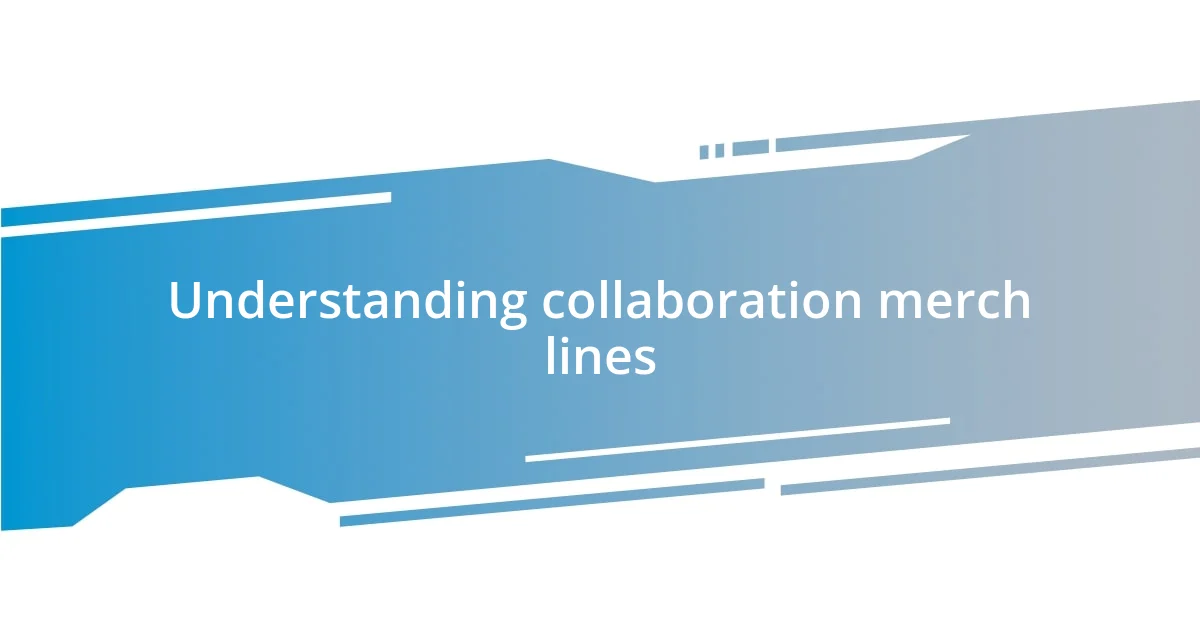Key takeaways:
- Collaboration merchandise blends identities of brands and creators, fostering emotional connections and community engagement.
- Successful collaborations, such as Nike x Off-White and LEGO x Star Wars, create innovative products that resonate culturally and emotionally with consumers.
- Effective marketing strategies include leveraging social media, creating urgency with limited offerings, and hosting interactive events to deepen brand loyalty and customer relationships.

Understanding collaboration merch lines
Collaboration merchandise lines bring together diverse brands and creators, creating unique offerings that often reflect a blend of their identities. I remember the excitement I felt when my favorite streetwear brand partnered with a renowned artist to release a limited-edition collection. It feels like witnessing a creative marriage, where each partner brings their strengths to the table, resulting in something truly special.
These lines not only appeal to loyal fans of each brand but also attract new customers who may be drawn in by the novelty and limited availability. Isn’t it fascinating how a simple hoodie can spark a conversation about art, culture, or even social issues? I’ve often found myself in conversations about collaboration merch that led to deeper discussions about the inspirations behind the designs and the stories each item tells.
Sometimes, the emotional connection behind these collaborations can be profound. I once purchased a pair of sneakers from a collaboration that aimed to raise awareness for mental health. Wearing them felt like a personal statement, connecting me to a larger cause. How often do we find ourselves not just buying a product, but actually supporting a movement?

Importance of collaboration in merchandising
Collaboration in merchandising is more than just a business strategy; it’s a way to foster creativity and build community. When two or more brands come together, it can create a powerful synergy that amplifies their message and reaches a wider audience. I once attended a pop-up event where a local coffee shop collaborated with a tattoo artist to create unique merchandise. The energy in the room was electric, with fans from both sides sharing stories and connecting over their favorite brews and designs. It felt like a celebration of diverse cultures blending seamlessly into one memorable experience.
- Collaboration leads to innovative products that might not exist otherwise.
- It taps into the strengths and fanbases of each partner, creating a win-win situation.
- These partnerships often tell compelling stories that resonate emotionally with consumers.
- Engaging with fans during a collaboration can strengthen brand loyalty and community relationships.
- The limited nature of collaborative merch can create urgency, prompting purchases amid excitement.
In my experience, these collaborations not only fulfill consumer desires for unique products but also create a sense of belonging within the community. Every piece feels like it carries an essence of the partnership’s creativity, which I find incredibly appealing and stimulating.

Popular examples of successful collaborations
When I think about successful collaborations, a standout example is the partnership between Nike and Off-White, led by the visionary designer Virgil Abloh. Their “The Ten” collection transformed classic Nike sneakers into artistic statements. I was genuinely blown away by how a simple reimagining of these shoes could evoke such deep emotions among sneakerheads and fashion enthusiasts alike. I recall seeing friends camped out overnight for a chance to snag a pair, and the palpable excitement in the air was unforgettable.
Another fantastic collaboration that comes to mind is the collaboration between LEGO and various pop culture franchises, like Star Wars. Mixing construction play with beloved characters brought nostalgia and creativity together in one package. I remember assembling my first LEGO Millennium Falcon set; the joy of building something so iconic made it more than just a toy; it became a cherished memory I could share with my family. This collaboration truly illustrates how blending elements from different realms can connect generations through play.
Lastly, the partnership between Adidas and Beyoncé’s Ivy Park line has created some iconic pieces that resonate beyond just sporty aesthetics. The collection not only redefined inclusivity in fashion but also embraced different body types and styles. I can’t help but admire how each drop generates buzz and excitement, not just for the gear itself but for what it represents in the fight for diversity in the fashion industry. It’s inspiring to see how collaborations can spark not just trends but movements that encourage self-expression and empowerment.
| Collaboration | Key Features |
|---|---|
| Nike x Off-White | Artistic reinterpretation of classic sneakers; high demand; cultural impact |
| LEGO x Star Wars | Nostalgic play; family bonding; creative construction |
| Adidas x Ivy Park | Inclusivity; empowering designs; trendsetting |

Tips for designing collaborative merchandise
When designing collaborative merchandise, start by spotlighting the essence of both brands. For instance, I remember working on a project where we merged a local art gallery’s aesthetic with a sustainable clothing line. The magic happened when we created designs that reflected both the vibrancy of the art and the eco-friendly values of the clothing. This blend not only appealed to the existing fanbases but also sparked curiosity among new customers.
Don’t underestimate the power of audience engagement during the design process. I’ve learned that soliciting ideas and feedback from fans can unveil unexpected avenues of creativity. In one collaboration I participated in, we hosted a brainstorming session with our followers, inviting them to contribute suggestions for products. The excitement from fans seeing their ideas come to life was contagious, and it fostered a connection that transformed casual buyers into passionate advocates for the brand.
Lastly, consider infusing storytelling into your designs. When collaborating, the narrative behind the products can resonate deeply with consumers. I once collaborated with a friend who ran a charity organization, and we designed T-shirts with each piece telling a story about the children we supported. Each shirt was more than just a fashion item; it became a conversation starter. The emotional connection people felt made those shirts bestsellers, proving that when you align with a cause or story, it resonates so much more effectively.

Marketing strategies for merch lines
One effective marketing strategy for merch lines is leveraging social media platforms to create buzz. I once witnessed a brand team up with influencers who genuinely resonated with the target audience. They shared authentic experiences with the merchandise, and the response was electric. It’s fascinating how a few strategic posts can turn a product launch into a trending topic almost overnight.
Another approach I’ve found successful is utilizing limited-time offerings. For instance, I recall a collaboration where the brand dropped a new line with exclusive pieces only available for a week. This sense of urgency created an emotional response among consumers. It’s interesting how the fear of missing out, or FOMO, can drive people to scoop up items they might not have considered otherwise.
Additionally, hosting interactive events can be a game-changer. I remember participating in a launch party where customers could engage directly with the collaborators and even customize some pieces. The excitement was palpable, and participants left with a sense of ownership and connection to the product. Isn’t it remarkable how these moments can turn casual fans into loyal customers? It’s these experiences that create lasting memories and deepen the relationship between the brand and its audience.

Evaluating success of collaboration partnerships
Evaluating the success of collaboration partnerships can be quite nuanced. From my experience, one of the key metrics to consider is the alignment of brand identities and values. I recall working with a lifestyle brand and a renowned artist, and while the collaboration generated buzz, the audience’s reaction was mixed. It became clear that when the fundamental messages don’t resonate, even high visibility doesn’t guarantee success.
Another factor to explore is the sales performance post-launch. In a past project, we saw a direct correlation between the active involvement of both brand communities and the resulting sales figures. Monitoring these numbers is critical, as they not only reflect immediate success but also hint at potential long-term impacts. Did you know that sometimes the strongest collaborations don’t yield quick profits but instead build loyalty over time?
Feedback from consumers serves as another valuable tool for evaluation. After a partnership where we designed products based on audience input, I found that customer satisfaction was through the roof! This not only validated our efforts but also provided insights for future collaborations. Engaging with customers post-purchase can lead to valuable lessons that shape the next venture, making the evaluation process a continuous journey rather than a one-time assessment. Have you ever considered how customer insights can help craft more meaningful partnerships? The answers may surprise you!
















